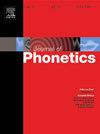Reconceptualizing VOT: Further contributions to marking 50 years of research on voice onset time
IF 2.4
1区 文学
0 LANGUAGE & LINGUISTICS
引用次数: 0
Abstract
Most work using voice onset time (VOT) to characterize voicing contrasts has focused on languages with two or three-way distinctions (Lisker and Abramson, 1964, Cho et al., 2019b). While this work acknowledges that VOT is not adequate to describe more complex voicing contrasts, there are few proposals addressing how such complex laryngeal contrasts can be characterized. In this post-facto addition to the special collection Marking 50 Years of Research on Voice Onset Time and the Voicing Contrast in the World’s Languages (Cho, Docherty, & Whalen, 2019a), I argue that VOT should be reconceptualized as a two-dimensional plane rather than a one-dimensional continuum. This simple reformulation of VOT, under which negative and positive VOT make up the complete VOT space, yields a more complete description of the voicing contrasts that exist in the world’s languages. Crucial evidence comes from Bengali which, like many other Indic languages, has a four-way contrast, utilizing both voicing and aspiration. If VOT is conceptualized as two-dimensional, the Bengali-type pattern is naturally predicted to exist. I argue that two-dimensional VOT best characterizes the acoustic properties of voicing contrasts and that the modest modification to our understanding of the VOT space proposed here can better explain the typology of stop laryngeal contrasts.
重新定义VOT:对语音起始时间研究50周年的进一步贡献
大多数使用语音开始时间(VOT)表征语音对比的工作都集中在具有两种或三种差异的语言上(Lisker和Abramson, 1964, Cho等人,2019b)。虽然这项工作承认VOT不足以描述更复杂的声音对比,但很少有关于如何描述这种复杂的喉部对比的建议。在《世界语言发声时间和发声对比研究50周年纪念特辑》(Cho, Docherty, &;Whalen, 2019a),我认为VOT应该被重新定义为一个二维平面,而不是一个一维连续体。通过对VOT进行简单的重新表述,消极VOT和积极VOT构成了完整的VOT空间,从而更完整地描述了世界语言中存在的发声对比。关键的证据来自孟加拉语,它和许多其他印度语言一样,有四个方面的对比,同时利用发声和渴望。如果将VOT概念化为二维的,那么孟加拉型模式自然会存在。我认为二维VOT最能表征发声对比的声学特性,并且本文提出的对我们对VOT空间的理解的适度修改可以更好地解释喉停对比的类型。
本文章由计算机程序翻译,如有差异,请以英文原文为准。
求助全文
约1分钟内获得全文
求助全文
来源期刊

Journal of Phonetics
Multiple-
CiteScore
3.50
自引率
26.30%
发文量
49
期刊介绍:
The Journal of Phonetics publishes papers of an experimental or theoretical nature that deal with phonetic aspects of language and linguistic communication processes. Papers dealing with technological and/or pathological topics, or papers of an interdisciplinary nature are also suitable, provided that linguistic-phonetic principles underlie the work reported. Regular articles, review articles, and letters to the editor are published. Themed issues are also published, devoted entirely to a specific subject of interest within the field of phonetics.
 求助内容:
求助内容: 应助结果提醒方式:
应助结果提醒方式:


